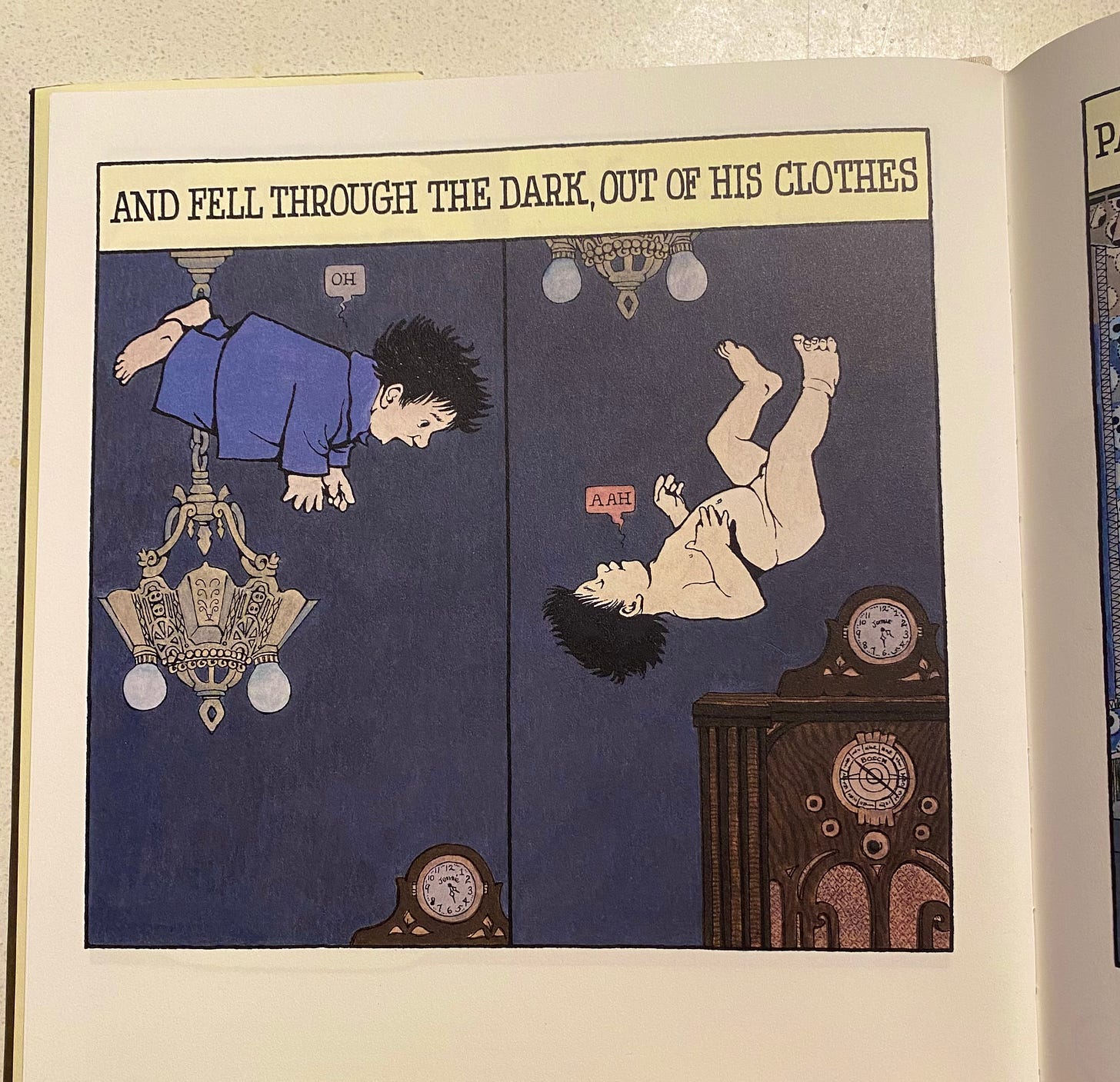During banned book week earlier this month, Elizabeth Held of
wrote a piece that prompted me to go looking for lists of them.One book jumped out at me for two reasons. It was by Maurice Sendak, the brilliant writer and illustrator who gave us Where the Wild Things Are — and it had the word “Kitchen” in the title. So I had to get it.
The reason for the ban: nudity.
When Sendak’s editor and friend, the legendary Ursula Nordstrom of Harper Junior Books found out, she wrote the following to the librarians banning (and at least one librarian actually burning) Sendak’s book, In The Night Kitchen:
I assume it is the little boys nudity that bothers you.
But truly, it does not disturb children!
There’s a 1991 article written by Sendak in the Los Angeles Times, “Why Mickey Wears No Pants” that tells the story of the ban, including the solution some librarians used of drawing diapers on the child.
As it turned out, quite a few librarians across the country preferred Mickey Fruit-of-the-Loomed…
To protect the children of course.
To read the entire LA Times article about the ban, click: Here.
The illustrations showing Mickey from the front, sans PJ’s, were the ones that really got the ban going.
To read more about editor and publisher Ursula Nordstrom’s click: Here.
In The Night Kitchen, a Caldecott Honor Book, was published in 1970. It’s the story of Mickey, a three-year-old, who has an adventure in dreamland.
He falls into the cake batter of three bakers working in the Night Kitchen who unknowingly put the cake in the oven with Mickey in it.
But Mickey triumphs, popping up and out of the batter and oven and becomes a hero for the bakers. He crafts a plane out of dough, puts a measuring cup on his head and flies to a giant milk bottle, getting the milk the bakers need for their cakes.
The bakers rejoice and Mickey is credited with being the reason we have cake every morning.
This is another ‘Children’s Book’ that offers plenty for the adult reader, not to mention Sendak’s gorgeous illustrations which have a surreal, sometimes unsettling beauty. Mickey is only able to access the dreamworld after “shedding” his clothes. Makes me want to read Carl Jung.
In a final, televised interview, Sendak (who was a very funny and renowned curmudgeon) said this to Stephen Colbert on the Colbert Report:
I don’t write for children.
I write.
And somebody says, “That’s for children.”
— Maurice Sendak, 2012
I’ve linked to the interview: Here.
In an obituary on NPR where Sendak had often been interviewed, it was recounted that he was drawn to scary adventures in his stories (one example: being put in an oven in In the Night Kitchen) that reflected childhood fears (the Wild Things were based on his aunts and uncles, who scared him when they’d say things like they wanted to “eat him up.”) He’d watched and listened as his parents, Polish-Jewish immigrants living in Brooklyn, grieved for loved ones killed in the Holocaust. He was also terrified by the kidnapping of the Lindbergh baby.
But Sendak always wanted people to know:
All my books end safely. I needed the security in my soul of bringing these children back.
We want them to end up OK, and they do end up OK. Unlike grown-up books.
And, heartbreakingly, unlike real life.
For the past ten days we’ve been witness to horror and unbearable sorrow that continues to unfold. My friend Joy wrote me this week that “We’re all doing our best to live open-hearted in this sometimes ugly, ugly world.”
One person who defines open-heartedness in the most difficult and tragic circumstances is Chef José Andrés. He and his team are already on the ground in Israel and Gaza, feeding the hungry. If you’d like to learn more about Chef’s organization, I’ve attached a link to World Central Kitchen here: https://wck.org or at his newsletter
A little sweetness
In a nod to Mickey’s cake, this is the easiest, old-fashioned-delicious cake (dates from 1900) to make to add a little sweetness to your week. It’s a great “anytime” cake —I put powdered sugar on top, or you can doll it up with whipped cream. It’s a hot milk cake — heating the milk with the butter, plus a batter made with whipped whole eggs makes for a beautifully tender crumb.
Recipe: Here
Before we go, if you are interested in learning more about children’s books, I highly recommend
‘s wonderful 📚 ✨Take good care, everyone. See you soon.
Jolene
Sendak, Maurice. In the Night Kitchen. New York, Harper Collins Publishers, 1970.













I seem to recall reading somewhere that there was additional concern because of the supposed symbolism of beating the dough, Mickey's "rising" to the milk bottle (and the milk itself) -- something about masturbation, etc. I can't remember the full nonsense, but to me that seems to stem more from a homophobic response to Sendak himself rather than the content of the actual book, which is definitely weird and not for everyone, but also strangely delightful. (I've always loved the rhythm of it, the pleasure of reading it aloud.)
Thank you, of course, for the shoutout. (It's like being in the NY Times -- MENTIONED ON TIME TRAVEL KITCHEN! 😉)
Crazy times we live in! I had Sendak for a children's book illustration class at Parsons. He always complained about librarians.